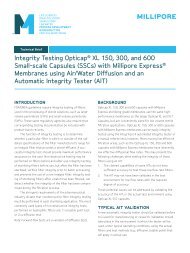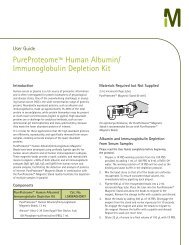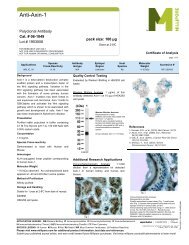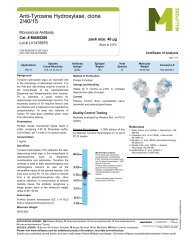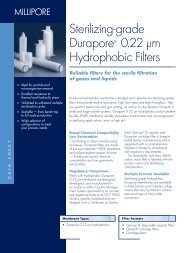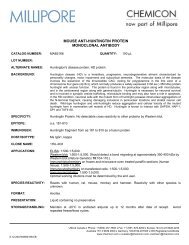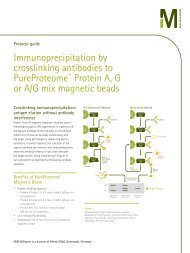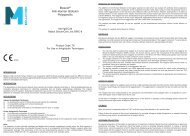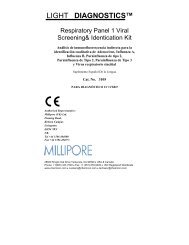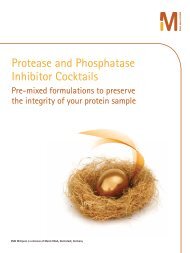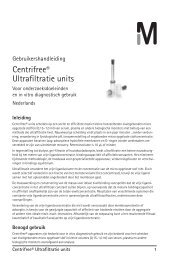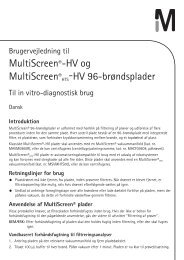Full Text Article - Millipore
Full Text Article - Millipore
Full Text Article - Millipore
You also want an ePaper? Increase the reach of your titles
YUMPU automatically turns print PDFs into web optimized ePapers that Google loves.
UV absorbance<br />
UV absorbance<br />
From tap to ultrapure water<br />
Using the water purification chain described<br />
previously, the various sampling points enable the<br />
organic decrease through the different water<br />
purification processes to be traced. The change in<br />
organic nature during water treatment does not allow<br />
direct contaminant identification.<br />
However, chromatogram profiles obtained, and<br />
especially at 214 nm, the more sensitive wavelength,<br />
highlight organic contamination removal through the<br />
purification stages (see Figure 8). This shows the<br />
importance of having a combination of technologies<br />
when producing ultrapure water from potable water.<br />
Conclusion<br />
0.050<br />
0.040<br />
0.030<br />
0.020<br />
0.010<br />
Milli-Q system water, 6 min after 6 hours<br />
0.000<br />
0.00 4.00 8.00 12.00 16.00<br />
Gradient Time (minutes)<br />
0.050<br />
0.040<br />
0.030<br />
0.020<br />
0.010<br />
214NM<br />
254NM<br />
Milli-Q system water, day 20<br />
214NM<br />
254NM<br />
0.000<br />
0.00 4.00 8.00 12.00 16.00<br />
Gradient Time (minutes)<br />
Figure 7: Ultrapure water baselines at 254 nm and 214 nm.<br />
The presence of impurities in the mobile phase, and<br />
especially in the purified water used for HPLC studies<br />
raises several issues:<br />
- These contaminants create peaks during gradient<br />
runs. This leads to problems with peak<br />
identification and peak quantitation.<br />
- The impurities contaminate and “kill” columns.<br />
- When solutions of standards are prepared with<br />
impurities contained in ultrapure water, inaccurate<br />
results are obtained for sample identification and<br />
quantitation.<br />
- Moreover, when preparative chromatography is<br />
performed, impurities in mobile phase and/or<br />
samples prepared, can contribute to contaminated<br />
fractions.<br />
A significant number of studies have shown the<br />
importance of water quality during HPLC analysis.<br />
Storage of high purity water is inadequate and<br />
inappropriate to obtain high quality baselines 11 .<br />
A.U. (254 nm)<br />
A.U. at 214 nm<br />
0.035<br />
0.030<br />
0.025<br />
0.020<br />
0.015<br />
0.010<br />
0.005<br />
0.000<br />
0.00 5.00 10.00 15.00 20.00<br />
0.035<br />
0.030<br />
0.025<br />
0.020<br />
0.015<br />
0.010<br />
0.005<br />
Time (minutes)<br />
Figure 8: From tap to ultrapure water, chromatographic profiles at<br />
254 nm (top) and 214 nm (bottom) (1 ml injected (Tap and RO)<br />
or 50 ml accumulated (EDI, reservoir and Milli-Q) on the<br />
C18 column).<br />
More and more sensitive detection methods are<br />
being coupled to HPLC in order to improve detection<br />
limits 12,13,14 .<br />
The mobile phase in RP-HPLC generally contains a<br />
“buffer” component, an organic modifier and, often,<br />
an ion pairing agent added to the mobile phase to<br />
influence selectivity. All solvents, buffering salts, ion<br />
pairing agents, as well as the water used to prepare<br />
the mobile phases, must be of high chemical purity.<br />
A water purification chain combining multiple<br />
technologies such as electrodeionization<br />
pretreatment, UV photooxidation and high quality<br />
purification media, and ensuring easy maintenance<br />
with automatic rinsing and flushing capabilities,<br />
delivers ultrapure water suitable for high sensitivity<br />
organic analyses. Additionally, the use of an<br />
ultrapure water system with on line TOC (Total<br />
Organic Carbon) analysis is the best way to monitor<br />
these organic contaminants at the point-of-use 15 .<br />
Tap<br />
RO<br />
EDI<br />
Reservoir<br />
Milli-Q<br />
0.000<br />
0.00 2.00 4.00 6.00 8.00 10.00 12.00 14.00 16.00<br />
Time (minutes)<br />
Tap<br />
RO<br />
EDI<br />
Reservoir<br />
Milli-Q<br />
The R&D Notebook: From tap to ultrapure water: tracking organic contaminants<br />
5



